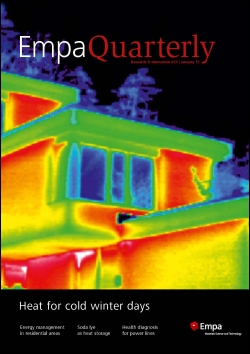EmpaQuarterly 2017
From cellphones and electric cars to storage batteries for apartment blocks: lithium ion batteries have taken the world by storm – and stoked the demand for electricity that is available around the clock. This poses two problems, however: firstly, high-performance batteries are flammable and have to be monitored while charging and discharging to make sure nothing happens.Secondly, the majority of lithium ion batteries come from Asia these days. The lifestyle in large parts of the world is, therefore, increasingly dependent on one supply region – much like during the oil crisis in the 1970s. It is clear that the popular lithium ion battery will eventually be replaced by new technologies. At Empa, several research teams are investigating potential solutions for the electricity conserves of the next few decades.
Sensors are usually electronic components that supply information on physical and chemical parameters in their surroundings. They act as a scientist’s sensory organ, helping to describe the changes in the world around us – or even in our bodies – as precisely as possible. Only if we comprehend and perceive our environment as fully as possible we can interact with it in a purposeful, meaningful way. Only with sensors can technology really become “smart”.
Sensors can be used to measure virtually anything, from relatively straightforward factors like temperature, pressure, brightness or acceleration to complex, abstract features such as the force be-tween two atoms or the concentration of a particular metabolic product in biological samples. This makes sensors hugely important in numerous research fields, as the current issue of EmpaQuarterly illustrates.
City driving is way different in laboratory dynamometers and in reality: Drivers start their cars from the cold and really floor the throttle to overtake. At traffic lights almost everyone tries to make up for lost time. Others look to flaunt the expensive horsepower they’ve splashed out on as they roar past sidewalk bars and cafes.
This driving behavior is stretching the exhaust gas cleaning in diesel and gasoline cars to its limits. Until now, the law has turned a blind eye precisely here and relied on unrealistic tests on test rigs to set limits and classify cars. As a result, some pollutants slip through the net (virtually) unbridled while others are only produced in the hot catalytic converter from the chemically reactive ingredients that the engine provides. But what really comes out the rear end? Empa has been on the case.
How can we organize energy supply in the post-fossil era? How can energy be stored efficiently? And how can we organize distribution as economically and conveniently as possible? Empa’s research platform “ehub” is searching for answers to these questions.
A combination of 13 different storage systems and energy sources supplies the futuristic residential area in the research building NEST and the vehicle pool of move, Empa’s future mobility demonstrator. The optimum control of such complex supply networks has never really been investigated – or tested in actual operation. The Energy Hub (ehub) demonstrator is set to change all this and should provide insights into a safe and sustainable energy of the future.

Empa Quarterly
Want to subscribe to our magazine? It's easy, simply click here.
Archive
Do you want more stories from Empa's labs? Check out previous issues of the magazine below.
-
Share





